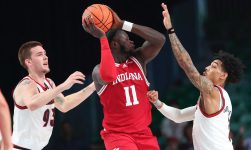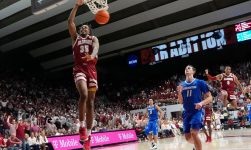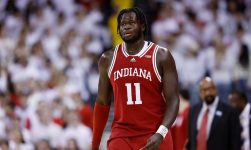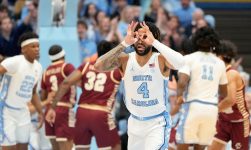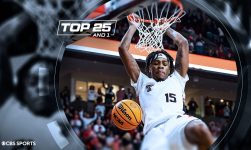College basketball is already in an era of transition, as loosened transfer restrictions and the arrival of the name, image and likeness era have changed the calculus in roster construction. Now, another monumental change might be in the works that could have a significant impact on the top of each recruiting class.
The NBA and NBPA are could potentially lower the minimum age for draft eligibility from 19 to 18 as soon as 2024, according to reports. In essence, the move would mean players could again jump straight from high school basketball to the NBA without making one-year stops somewhere else. Since 2005, one-and-done players have become a staple of college hoops as they regularly saw a season on a university campus as the best way to bridge the required gap between high school and the professional ranks.
So what would this mean for college basketball? The sport has survived a lot in recent years, and this development looks like just the latest curveball. So for this edition of the Dribble Handoff, our team of writers is weighing in on whether they think the potential change to the minimum draft age would be good or bad for college basketball.
College basketball might be hurt, but will be fine
I think it’s clear that losing the so-called one-and-done rule would hurt college basketball more than help considering we’ll again start missing out on some of the best prep talent every year — i.e., the next versions of Kevin Durant, Derrick Rose, Jayson Tatum, Carmelo Anthony, Zion Williamson, Anthony Davis, Lonzo Ball and any other prospect gifted enough to convince an NBA franchise to spend a first-round pick on him after high school. That’s not great. But I’m still in favor of the rule going away because A) college basketball will be fine regardless, and B) it’s simply the right thing to do.
It’s been proven, over and over again, that the top high school prospects are perfectly capable of succeeding via the prep-to-pro route. From 1995 through 2005 — otherwise known as the 11-year window during which prep prospects entered the NBA Draft regularly before the one-and-done rule started preventing it — a franchise used a first-round pick on exactly 29 high school players. At least five of those players (and maybe six depending on what you think of Amar’e Stoudemire) will end up as Naismith Memorial Hall of Famers. And eight of the 29 made at least one NBA All-Star Team. In other words, if you spent a first-round pick on a high school player between 1995 and 2005, there was a better than 20% chance you were getting a future Hall of Famer, and a 27.6% chance you were at least getting a future NBA All-Star. That’s an incredible hit-rate and proof that the prep-to-pro era that brought Kevin Garnett, Tracy McGrady, Kobe Bryant, LeBron James and Dwight Howard to the NBA was, broadly speaking, great for the prospects and franchises involved. It was fine last time. It’ll be fine this time. And, more than anything else, it’ll represent a system that’s more right and fair once again. — Gary Parrish
NBA age limit significantly boosted college hoops’ star power
Feast your eyes on the list of players below. These are prospects since 2006 who came out of high school ranked in the top 10 in their graduating class and/or became highly drafted one-and-done All-American talents who played just one season of college basketball. It’s safe to speculate that the overwhelming majority would have gone straight to the NBA if allowed. Instead, college basketball had them as stars for a season.
The list is long; that’s the point.
Kevin Durant, Greg Oden, Eric Gordon, Michael Beasley, Derrick Rose, Kevin Love, Jrue Holiday, DeMar DeRozan, John Wall, DeMarcus Cousins, Derrick Favors, Lance Stephenson, Kyrie Irving, Tobias Harris, Anthony Davis, Austin Rivers, Michael Kidd-Gilchrist, Bradley Beal, Nerlens Noel, Andrew Wiggins, Julius Randle, Aaron Gordon, Jabari Parker, D’Angelo Russell, Ben Simmons, Brandon Ingram, Jaylen Brown, Karl-Anthony Towns, Jahlil Okafor, Lonzo Ball, Jayson Tatum, De’Aaron Fox, Bam Adebayo, Malik Monk, Trae Young, Deandre Ayton, Marvin Bagley III, Zion Williamson, RJ Barrett, Vernon Carey Jr., Anthony Edwards, Cole Anthony, Cade Cunningham, Evan Mobley Jr., Scottie Barnes, Jalen Suggs, Chet Holmgren and Paolo Banchero.
There are national champions, national players of the year, national freshmen of the year, All-Americans, program-changing talents on that list of 48 players. No, they didn’t stick around long in college. Yes, they increased the sport’s wattage in an era when college hoops sorely needed as much name recognition and star power as it could muster.
I remain skeptical of how soon this rule change will actually take place because it’s long been the position of the NBA Players Association to not revert back to prior protocol. And an ESPN report from Monday also indicated if the change does happen, we could be waiting a bit longer than 2024. Nevertheless, this NBA rule change might be the “right” thing to do, but it would unquestionably hurt college basketball’s product in the process if and when it comes to pass. Don’t believe me? Read that list of names again. — Matt Norlander
More college stars would stay in school
I’m firmly of the belief that ending the one-and-done era would be a net positive for college hoops. There would be a noticeable talent drain initially — over the last decade there have been roughly three true freshmen per year go on to be All-Americans, most of whom were one-and-dones — but the sport would eventually recover to reclaim an older demographic and evolve easily into a new era. That would likely feature more recognizable names staying longer and cashing in bigger pieces of the NIL pie, which in turn would be a boon for the sport. The ruthless roster churn of the one-and-done era has in part been why I think general interest in the sport has waned in recent years; that could be directly addressed with the age qualification change for the NBA Draft.
The one-and-done era wouldn’t truly end, either, to be clear. The volume of bona fide five-stars with surefire lottery prospects flowing into college hoops would probably decrease significantly — no longer would the Zion Williamsons or Cade Cunninghams go to college when they could go be top-five picks — but they wouldn’t cease altogether just because the draft-eligible age is decreased by a year. More likely than not, one-and-done would simply exist in a different form — with later rising prospects stepping into a void previously reserved for the elite of the elite in the true one-and-done era.
College basketball players and rosters being older will I think be the biggest unintendedly positive outcome if the draft eligibility age changes. The sport thrives when good players stay longer, leaving lasting memories on the sport. The Tyler Hansbrough era at North Carolina. The Adam Morrison era at Gonzaga. The J.J. Redick era at Duke. The sport may lose out on top-end talent more consistently if elite talents don’t attend college or leave for the NBA early as they have done, but fringe NBA players — or even just good college players who maybe don’t project well to the NBA — staying longer in the college ranks would be a win for the NBA and for college basketball as both transition into a new, exciting era. — Kyle Boone
College basketball could get more competitive
Oh, goody. Just when college basketball had outraced the death sentences pronounced after the creation of G League Ignite and Overtime Elite, more news has arisen that will supposedly spell doom for the sport. Don’t buy it. Sure, the potential end of the one-and-done era would make promoting a Tuesday night game between NC State and Duke more difficult for TV networks, but college basketball has always been about more than just the stars. As someone who fell in love with college athletics in the late 1990s and early 2000s, it never matted to me that Amar’e Stoudemire, LeBron James or Dwight Howard didn’t play college basketball. In fact, the endless praise and attention that would have been lavished upon those players in college basketball would likely have only distracted an impressionable mind from the things which truly make college basketball great.
Sports fans who need one-and-done stars spoon-fed to them by our 21st century hype machines in order be interested in college basketball are not true fans of the sport. If losing some of those casuals means some weeknight games some lower TV ratings, it will mean exactly nothing. Football drives the TV money, and fans of college basketball’s biggest fan bases are going to watch regardless of who is wearing the uniform. This change may actually enhance the purity of the sport. If a select handful of coaches can no longer rely on a supreme talent advantage, it levels the playing field and puts a greater premium on schematics and player development, which makes the coaching profession slightly more of a meritocracy and slightly less of a recruiting contest won by the highest bidder.
The much bigger threat to college basketball right now that needs to be addressed is the prospect of major change to the NCAA Tournament. SEC commissioner Greg Sankey is floating proposals that could legitimately ruin the sport. Changing the draft age is not one of them. — David Cobb

